#robotic process automation in healthcare
Text
Unlocking Efficiency and Innovation: The Role of Robotic Process Automation (RPA)
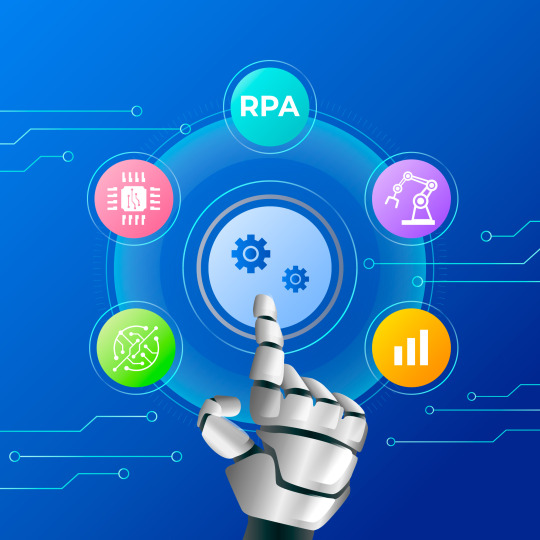
In today's fast-paced and competitive business environment, organizations are constantly seeking ways to improve efficiency, reduce costs, and increase productivity. Robotic Process Automation (RPA) has emerged as a powerful tool that can help businesses achieve these objectives.
What is Robotic Process Automation (RPA)?
Robotic Process Automation (RPA) is a technology that allows businesses to automate repetitive, rule-based tasks. It uses software robots, also known as "bots," to mimic human actions and interact with digital systems. These bots can log into applications, navigate through screens, input data, and complete tasks just like humans would.
The Role of RPA in Business:
RPA can be used to automate a wide range of tasks across various industries and departments. Here are some examples:
Finance and Accounting: Automating tasks such as accounts payable and receivable, invoice processing, and financial reporting.
Customer Service: Automating tasks such as answering FAQs, resolving customer inquiries, and processing orders.
Human Resources: Automating tasks such as onboarding new employees, processing payroll, and managing benefits.
IT: Automating tasks such as provisioning accounts, managing user access, and deploying software updates.
Impact of RPA on Businesses:
Implementing RPA can offer numerous benefits to businesses, including:
Increased efficiency and productivity: RPA can automate time-consuming and tedious tasks, freeing up employees to focus on more strategic and value-added activities.
Reduced costs: RPA can help businesses save money on labor costs, as well as reduce errors and compliance risks.
Improved accuracy and compliance: RPA bots are programmed to follow specific rules and procedures, which can help to improve accuracy and compliance with regulations.
Enhanced process visibility and control: RPA provides businesses with a clear view of their processes, which can help them identify and address bottlenecks.
Improved customer satisfaction: RPA can help businesses improve customer satisfaction by automating tasks such as order processing and customer service interactions.
RPA Services:
Implementing RPA successfully requires a partner with expertise in the technology and a deep understanding of business processes. A comprehensive RPA solution should include the following services:
Document AS-IS Process: This involves mapping out the existing process to identify areas for automation.
Design & Development of Bots, workflows, and forms for process automation: This includes designing and developing the software robots that will automate the tasks.
Bot license (We will use the appropriate underlying technology): This provides access to the software robots and the underlying technology platform.
Infrastructure: This includes setting up the necessary infrastructure to support the Robotic Process Automation (RPA) solution.
Production Deployment of the Bots: This involves deploying the bots to production and monitoring their performance.
RPA support: This includes ongoing support for the RPA solution, such as troubleshooting and maintenance.
Test & Deploy bots to production: This involves testing the bots in a production environment and making any necessary adjustments before they are deployed to full production.
Configuration data changes: This involves making changes to the configuration data of the bots as needed.
Password updates: This involves updating the passwords of the bots as needed.
Errors in executing the Bots: This involves resolving errors that occur during the execution of the bots.
Determining the “root cause” of a recurring issue or incident & recommendations: This involves identifying the root cause of a recurring issue or incident and recommending solutions to prevent it from happening again.
Infrastructure/application related issues: This involves resolving issues with the infrastructure or applications that the bots are interacting with.
Conclusion:
RPA is a powerful technology that can have a significant impact on businesses of all sizes. By automating repetitive tasks, RPA can help businesses improve efficiency, reduce costs, and increase productivity. However, it is important to choose a reputable Robotic Process Automation (RPA) companies with the expertise and experience to help you implement a successful RPA solution.
Ready to embrace the power of RPA?
Contact us today to learn more about how RPA can help your business achieve its goals.
#robotic process automation#robotic process automation rpa#rpa automation#robotic process automation software#rpa software#robotic process automation companies#robotic process automation technology#robotic process automation in healthcare#robotic process automation in banking#rpa solution#robotic process automation for finance#process automation solution#robotic process automation services#robotic process automation for insurance#rpa system#what is rpa automation#robotic process automation solution#robotic process automation benefits#robotic process automation consulting#robotic process automation consultant#rpa service provider#rpa consulting services
2 notes
·
View notes
Photo

This is where RPA in healthcare industry comes in as it automates certain processes which ensures that healthcare professionals can focus on patient care rather than other tedious tasks. Solution Analysts offers Robotic Process Automation services which help businesses adopt a process automation strategy to fulfil long-term goals.
#RPA in Healthcare#RPA in healthcare industry#Robotic Process Automation in healthcare#Benefits of RPA in Healthcare
2 notes
·
View notes
Text
Maximizing Efficiency in Healthcare: Katpro Technologies' RPA Solutions
Unlock the potential of robotic process automation in healthcare with Katpro Technologies. Discover how our customizable RPA solutions streamline repetitive tasks, reduce errors, and boost operational efficiency in healthcare organizations. Stay ahead of the curve with Katpro's innovative approach to automating processes like patient data entry, claims processing, and inventory management. Experience the future of healthcare management today with Katpro Technologies.

0 notes
Text
Robotic Process Automation In Healthcare | RPA Consulting Services | NuAIg
NuAig is the best RPA consulting service provider that delivers bespoke robotic process automation solutions in the healthcare and senior living industry. They have a team of experts who implement RPA automation for aged care providers and healthcare firms. Check out the RPA use cases to know more about process automation using robotics technology. To book a demo mail at [email protected] call +1 732 328 8205
#robotic process automation in healthcare#robotic process automation#rpa automation#digital process automation#rpa solutions#robotic process automation services#rpa in healthcare#rpa consulting#rpa implementation#rpa use cases#robotic process automation solutions#rpa consulting services#rpa service provider#rpa advisors for senior living#rpa application for senior living#rpa for caregiver onboarding#rpa services for senior living
0 notes
Text
#RPA healthcare#robotic process automation in healthcare#automation in healthcare#healthcare automation solutions
0 notes
Text
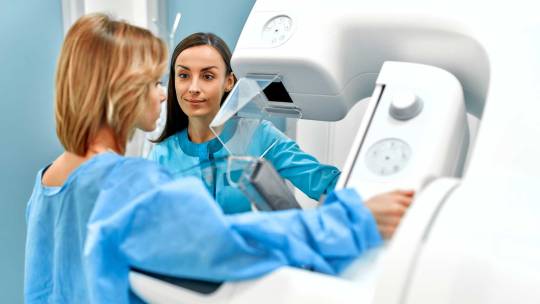
Cancer Care Follow-up automation developed by a Finnish company improves patient safety and aims to save hundreds of millions of euros
#intelligent automation#robotic process automation#intelligent automation in healthcare#rpa in healthcare
0 notes
Text
Revolutionizing Healthcare Efficiency: The Power of Robotic Process Automation (RPA)
In the dynamic realm of healthcare, embracing innovation is crucial for achieving operational excellence and providing unparalleled service to both healthcare institutions and patients. Robotic Process Automation (RPA) emerges as a transformative force, streamlining processes, enhancing operational efficiency for hospitals, and delivering substantial value for patients. This article delves into the impactful role of RPA in the healthcare industry, shedding light on its operational benefits and cost-reducing capabilities.
Navigating Healthcare Efficiency with RPA:
Optimizing Operational Processes: Robotic Process Automation plays a pivotal role in optimizing routine and rule-based tasks, allowing healthcare professionals to redirect their efforts towards critical aspects of patient care. This results in a more efficient workflow across various operational facets of healthcare institutions.
Revolutionizing Administrative Processes: RPA introduces a new era of efficiency by automating administrative tasks such as appointment scheduling, billing, and claims processing. This not only reduces errors but also accelerates these processes, leading to minimized delays and improved overall service delivery.
Cost Reduction Initiatives: One of the significant advantages of RPA in healthcare is its potential for substantial cost reduction. By automating repetitive tasks, healthcare institutions can achieve operational cost savings, enabling better resource allocation to essential areas of patient care.
Revolutionizing Hospital Services:
Ensuring Precision in Data Processing: RPA ensures the accurate and timely processing of extensive healthcare data, contributing to improved data accuracy and integrity. In an industry where precision is paramount, RPA plays a crucial role in making informed decisions about patient care.
Elevating Patient Communication: Automation facilitates improved communication with patients through timely reminders, updates, and personalized interactions. This not only enhances the overall patient experience but also contributes to better engagement and adherence to treatment plans.
Expedited Claims Processing: Healthcare providers can expedite claims processing through RPA, reducing the time required for insurance claims and ensuring faster reimbursement. This benefits hospitals financially and contributes to a more seamless experience for patients.
Empowering Patients with RPA:
Enhancing Healthcare Accessibility: RPA eliminates administrative bottlenecks, contributing to improved healthcare accessibility. Patients experience faster appointment scheduling, reduced waiting times, and more efficient services overall.
Personalized Care Delivery: Through automation, healthcare providers can efficiently gather and process patient data, enabling them to offer personalized and targeted care plans. This fosters a patient-centric approach to healthcare delivery.
Call to Action (CTA): Embrace Healthcare Innovation with RPA!
Ready to witness the transformation of healthcare operations and enhance patient experiences? Explore the profound impact of Robotic Process Automation in the healthcare industry by visiting RPA in Healthcare.
0 notes
Text
Enhancing Immunity - Defending Against Social Engineering Attacks

Social engineering is a form of psychological manipulation used to gain access to confidential information or resources. This tactic is often used by criminals and hackers who use deception, manipulation, and influence tactics to exploit people’s trust in order to gain access to sensitive data in IT operations. Social engineering can be used for malicious purposes such as identity theft or financial fraud, or it can be used for more purposes such as marketing campaigns. In either case, social engineering relies on exploiting human psychology in order to achieve its goals.
Social engineering attacks are becoming more and more common as hackers become increasingly sophisticated. It is important for companies to understand the steps involved in a social engineering attack so that they can take steps to protect themselves from such threats.
Social engineering attacks involve manipulating people into revealing sensitive information or granting access to systems, networks, or physical premises. These attacks typically involve tricking people into giving out confidential information by exploiting their trust and lack of security knowledge. The attacker may also use physical means such as impersonation or tailgating to gain access to restricted areas.
In order to protect against social engineering attacks, it is important for companies to be aware of the steps involved in such an attack. This includes understanding how attackers use psychological tactics, how they exploit human weaknesses, and what measures can be taken to prevent such attacks from occurring.
Social engineering attacks are one of the most common cyber threats that organizations face today. These attacks use psychological manipulation and deception to gain access to sensitive information or resources. They can take many forms, including phishing emails, malicious links, and impersonation scams.
Awareness of Social Engineering Attacks
Validating the identity of the user with whom we are doing business
Checking for the authenticity of the attachments and the email we get in our inbox
Double-checking the content and legitimacy of the offers and discounts which are sent to us
Verifying the email address, domain, and social media profiles carefully when we get a message from the suspect
Preventing Social Engineering Attacks by Improvising IT Network Immunity
Use of Multifactor authentication adds one extra layer of the security
Adaptive authentication plays a key role in safe authentication
Having a strong password policy or password manager will ensure the user passwords are of not compromised easily
Defining the software access policies
Using desktop virtualization software to give you private, encrypted access to the network connection
Read more @ www.gavstech.com/enhancing-it-network-immunity-to-defend-against-social-engineering-attacks/
#ai in cyber defense#ai devops automation service tools#healthcare database software development#mobile app development#optimal clinical software development#digitaltransformationinhealthcareitconsulting#digital transformation in healthcare it consulting#digital transformation solutions#big data and predictive analytics in healthcare#global it services & solutions provider#robotic process automation coe#microsoft cloud solution provider#predictive analytics in healthcare#business process automation in healthcare
0 notes
Text
Oracle Flexcube: A Comprehensive Examination of its Role in Automation Solutions
Oracle Flexcube is an integrated, enterprise-wide software that provides a single platform for all financial product processing activities by providing centralize data management and enhanced automation workflow processes. In this article, we'll take a closer look at how Oracle FlexCube can be used to streamline enterprise operations across the entire organization.
Oracle Flexcube is designed to provide users with an end-to-end platform that simplifies financial product processing and increases operational efficiency of the customer-centric services. The software offers features such as one view reporting, dynamic business rule creation engine, personalized dashboard designer, maximum utilization of existing resources and extensive support for multiple languages. It also integrates with a variety of existing solutions provided by Oracle to automate activities that are necessary to effectively run the business.
These features give organizations the tools they need to efficiently manage customer relationships and transactions on a wide range of devices including web-based applications and mobile phones. With Flexcube’s data integration technology, organizations can access their customer information from any location without additional hardware or IT infrastructure investments. This helps them increase their performance in customer service as well as reduce IT costs associated with manual data entry tasks.
Flexcube also provides advanced analytics capabilities which enable businesses to gain insights into customer behaviors and interactions through data analytics tools such as machine learning algorithms and natural language processing (NLP) technology. By leveraging these technologies businesses can ensure that customers receive better services in both online and offline channels; this leads to a higher level of satisfaction among clients who actively participate in the process through self-service options or real-time interactions with support representatives via chatbot conversations or virtual assistants.
With its advanced analytics capabilities, businesses can use Flexcube not only for automation but also for predictive scenarios such as market segmentation or proactive marketing campaigns which can help enterprises stay ahead of the competition by recognizing market changes earlier than its rivals do. Ultimately, Oracle Flexcube has become an increasingly valuable tool for organizations looking for optimized solutions within increasingly demanding industries such as banking & finance, insurance & healthcare, or retail & logistics due its capability to integrate easily with enterprise systems while providing robust data management capabilities across multiple dimensions including customers, accounts/transactions., products portfolios & markets served.
#RPA software#RTA software#RMA software#EOD process#Banking and financial Automation#Oracle Flexcube Automation#Insurance automation#Healthcare automation#IT and Consultancy services automation#Intelligent Document Processing#Banking and financial services#IT and Consultancy services#iBorg automation#iBorg automation tool#all in one hybrid automation tool#iBorg hybrid automation tool#Automation Tool#Automation Software#Robotic Process Automation#Robotic Test Automation#Robotic Mobile Automation#Intelligent Process Documentation#Oracle flexcube#automation solution#robotic automation#Banking software
0 notes
Text
RPA in Healthcare- How RPA is Changing the Healthcare Industry
Robotic Process Automation (RPA) is among the most promising and efficient solutions across the world. It helps in reducing expenses from financial institutions to manufacturing sectors and also decreases overall production time. It is software that can automate tasks in the healthcare industry and provide better services to patients.
RPA is changing the way healthcare is provided. It has been seen as a solution for hospitals and clinics to improve their efficiency and reduce costs. It has been used in hospitals, clinics, and research centers to automate tasks such as scheduling appointments, ordering lab tests, and even patient monitoring. With the help of RPA, it has now become possible to streamline the healthcare system.
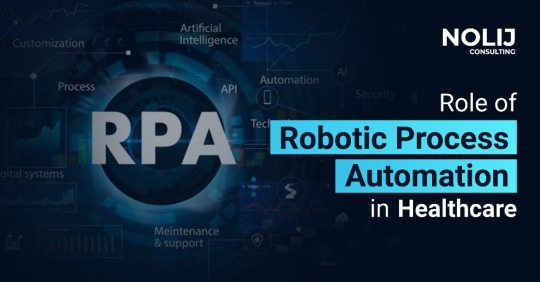
How Is RPA Changing the Healthcare Industry
1. Enhancing patient satisfaction
A satisfied patient is a key part of any thriving healthcare system. Without being able to effectively schedule appointments and process check-ins, patients will become frustrated, which can lead to other issues. With an automated healthcare process, patients can schedule their appointment anytime they want through their devices, without waiting around in a waiting room. RPA or robotic process automation improves efficiency by eliminating human error, allowing staff to focus on patient-centered activities, and increasing the quality of the job.
2. Improving Healthcare Cycles
Healthcare institutions collect a lot of data from patients, which is stored in databases. They're important to digest and analyze, as extracting & optimizing such data can be difficult. By implementing RPA emerging technology services in healthcare, bots can collect and keep track of all patients’ data. Additionally, automation in medical records has made it incredibly easy for doctors by eliminating the need to handle data manually and letting automated bots do this. That time allows doctors more time to attend to things like human assistance with patients.
3. Cutting human-labor costs
Once healthcare service providers automated repetitive tasks, they could reduce the cost of labor and make processes more efficient. Apart from reduced cost, repetitive tasks are being vastly simplified in the healthcare industry due to the implementation of RPA. Automation can help improve efficiency and productivity for healthcare professionals and make them focus on higher-value portions of their tasks.
4. Enhancing Precision and Speedy Medical Diagnosis
Time is vital in healthcare. If a problem is not diagnosed quickly, it can lead to a less-than-optimal outcome. With RPA emerging technology services in healthcare, it's easy for doctors to make an appointment for a patient and make quick diagnoses. They also can get a patient's medical history, current diagnosis, and personal preferences to help them diagnose what the patient might be facing.
Technology has made it much easier to save time, minimize errors, & make sure accuracy. This is why hospitals are turning to RPA.
Conclusion:
Technology is improving healthcare which saves time, effort, and money. Robotic Process Automation (RPA) provides emerging technology services that can help healthcare providers focus on the right people, tackle problems more quickly, and increase patient satisfaction. In addition, it helps to enhance data collection and analysis, which supports evidence-based data in a healthcare organization.
#RPA emerging technology services in healthcare#robotic process automation service providers#health information technology company#software test management tools#infrastructure operations and maintenance services#enterprise data architecture solutions#infrastructure engineering and asset management solutions
0 notes
Text
Advancement of (Robotics Process System) RPS in Healthcare
With the Advancement of (Robotics Process System) RPS in Healthcare, the care technology is growing at an unimaginable speed and the impact it has on every aspect is inscrutable. The fact that it is still unexplored makes it even more unique. This is what we are going to have a look at in this blog.
We will see what RPS has at stake for healthcare, and what are the benefits of RPS in the healthcare industry. So, without further ado, let’s jump straight to what exactly is Robotics Process System.
What is RPS (Robotics Process System)?
Robotics Process System is a type of software program designed to perform specific administrative tasks. It uses software robots, which can mimic human and computer business interactions, and perform various management tasks at high speed.
Robotics Process System automates repetitive tasks at work. The use of bots to perform repetitive work is another example of transferring multiple files to different locations and processing several copies.

RPS in Healthcare
The medical care area in any nation is a complex yet basic framework for the prosperity of the residents. It includes clinical gear, health care coverage, and clinical preliminaries, from there, the sky’s the limit.
With the advancement of Robotics Process System in Healthcare, brings down functional expenses, increments functional productivity, and lessens human blunder in information handling.
Robotics Process System frameworks can deal with data in a record time and address difficulties coming about because of human mistakes.
Benefits of RPS in Healthcare
• Reduces Processing Cost
Robotics Process System Reduces the overall cost of Processing. As it Automates the whole revenue cycle functions like claims and billing. Moreover, it increases the operational control which further improves the patient experience.
• Strengthen Billing Cycle
Creditor liabilities and information digitization cycles can be computerized through RPS. This way further develops charging effectiveness. By redesigning managerial cycles, medical organizations can fundamentally streamline work and monetary assets.
• Reduces Man-Power Cost
By giving robots physically concentrated undertakings, medical services experts save time. They can utilize these extra time assets to create higher-esteem work. For example, by zeroing in on more fine-grained patient participation as opposed to information section, consequently growing their clinical preparation.
Advancement of (Robotics Process System) RPS in Healthcare
With the advancement of RPS in healthcare, the whole scenario of care has seen a drastic change. It has taken it to the next level & yet to be explored. Furthermore, here are a few ways RPS can leverage healthcare with its advancement.
Robotics Process System digitizes the documentation process, making it easier to handle & access the data.
Eases the scheduling process. With the advancement of RPS in healthcare, it’s pretty easy to schedule, cancel, or update appointments through bots.
Automate the Billing & Processing process. Being a repetitive process it’s hard to maintain the billing process. However, it is easier to automate the whole process using Robotics Process System in healthcare.
The growth of RPS in healthcare has sparked several changes and altered the delivery of medical care. As a result, the world enjoys a healthy environment with effective life-saving transportation management.
Source: medzinc
#robotics#robotics process automation#robotics engineering#healthcare#robotics in healthcare#RPS#robotics process systems
1 note
·
View note
Text
AI & IT'S IMPACT
Unleashing the Power: The Impact of AI Across Industries and Future Frontiers
Artificial Intelligence (AI), once confined to the realm of science fiction, has rapidly become a transformative force across diverse industries. Its influence is reshaping the landscape of how businesses operate, innovate, and interact with their stakeholders. As we navigate the current impact of AI and peer into the future, it's evident that the capabilities of this technology are poised to reach unprecedented heights.
1. Healthcare:
In the healthcare sector, AI is a game-changer, revolutionizing diagnostics, treatment plans, and patient care. Machine learning algorithms analyze vast datasets to identify patterns, aiding in early disease detection. AI-driven robotic surgery is enhancing precision, reducing recovery times, and minimizing risks. Personalized medicine, powered by AI, tailors treatments based on an individual's genetic makeup, optimizing therapeutic outcomes.
2. Finance:
AI is reshaping the financial industry by enhancing efficiency, risk management, and customer experiences. Algorithms analyze market trends, enabling quicker and more accurate investment decisions. Chatbots and virtual assistants powered by AI streamline customer interactions, providing real-time assistance. Fraud detection algorithms work tirelessly to identify suspicious activities, bolstering security measures in online transactions.
3. Manufacturing:
In manufacturing, AI is optimizing production processes through predictive maintenance and quality control. Smart factories leverage AI to monitor equipment health, reducing downtime by predicting potential failures. Robots and autonomous systems, guided by AI, enhance precision and efficiency in tasks ranging from assembly lines to logistics. This not only increases productivity but also contributes to safer working environments.
4. Education:
AI is reshaping the educational landscape by personalizing learning experiences. Adaptive learning platforms use AI algorithms to tailor educational content to individual student needs, fostering better comprehension and engagement. AI-driven tools also assist educators in grading, administrative tasks, and provide insights into student performance, allowing for more effective teaching strategies.
5. Retail:
In the retail sector, AI is transforming customer experiences through personalized recommendations and efficient supply chain management. Recommendation engines analyze customer preferences, providing targeted product suggestions. AI-powered chatbots handle customer queries, offering real-time assistance. Inventory management is optimized through predictive analytics, reducing waste and ensuring products are readily available.
6. Future Frontiers:
A. Autonomous Vehicles:
The future of transportation lies in AI-driven autonomous vehicles. From self-driving cars to automated drones, AI algorithms navigate and respond to dynamic environments, ensuring safer and more efficient transportation. This technology holds the promise of reducing accidents, alleviating traffic congestion, and redefining mobility.
B. Quantum Computing:
As AI algorithms become more complex, the need for advanced computing capabilities grows. Quantucm omputing, with its ability to process vast amounts of data at unprecedented speeds, holds the potential to revolutionize AI. This synergy could unlock new possibilities in solving complex problems, ranging from drug discovery to climate modeling.
C. AI in Creativity:
AI is not limited to data-driven tasks; it's also making inroads into the realm of creativity. AI-generated art, music, and content are gaining recognition. Future developments may see AI collaborating with human creators, pushing the boundaries of what is possible in fields traditionally associated with human ingenuity.
In conclusion, the impact of AI across industries is profound and multifaceted. From enhancing efficiency and precision to revolutionizing how we approach complex challenges, AI is at the forefront of innovation. The future capabilities of AI hold the promise of even greater advancements, ushering in an era where the boundaries of what is achievable continue to expand. As businesses and industries continue to embrace and adapt to these transformative technologies, the synergy between human intelligence and artificial intelligence will undoubtedly shape a future defined by unprecedented possibilities.
19 notes
·
View notes
Text
Applications of Robotic Process Automation in Healthcare Industry
Incorporating robotic process automation healthcare solutions revolutionizes administrative tasks, patient care, and operational efficiency. Discover how RPA streamlines workflows, optimizes resources, and ensures accuracy, empowering healthcare professionals to focus on delivering exceptional patient outcomes.
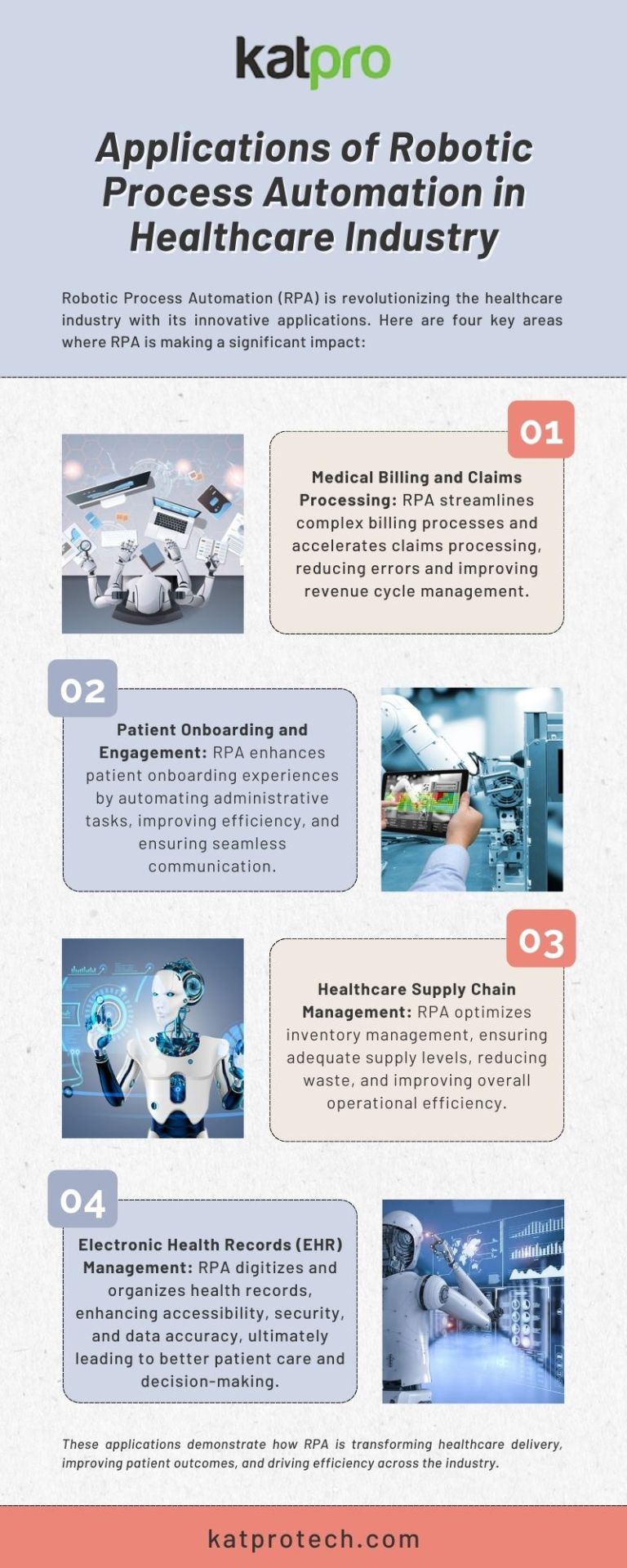
0 notes
Text
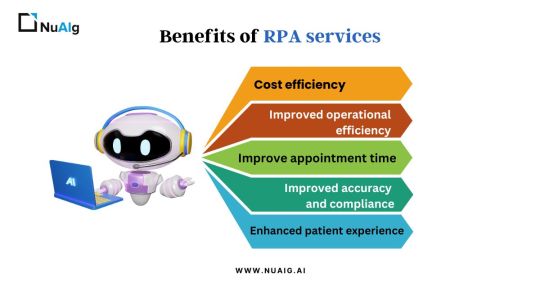
#rpa#robotic process automation#rpa services#rpa consultant#rpa in healthcare#rpa for healthcare#rpa consulting#rpa service company
0 notes
Text
Trends in AI & Generative AI: Insights from The 2023 AI Summit New York

Last week, I covered the AI Summit in New York. I was excited to learn about the trends in AI and generative AI and to see some commercial applications of these new technological advancements.
Patrick Murphy of UAB led the AI Exhibitor hub. Patrick shared insights from his research on Entrepreneurship. He shared how start-ups use AI, and Generative AI to scale up and bring products to market.

Generative AI is being used in the following eight ways:
Content and Asset Generative
Automated Processes
Ideation
Financial Management
Project Design
Optimized Structures
Acceleration and incubation
Ethics and Risk Management.
There was a pitching completion where start-ups did pitches in multiple rounds. At the beginning of the competition, they received advice from judges on best practices.

One of the start-ups that was of interest was Botwise. Jan Nowak shared how his team shared a use case on how they leveraged Language Learning models (LLM)using statistics and GPT solutions for rapid automation in customer service for Mylead.global is a platform that allows influencers to earn money. As a result, MyLead.global was able to screen influencers faster and better for their big brand clients.

AI-Powered Use Cases from across the board panel discussion
Leaders Saira Kazmi Ph. D. (CVS Health), Matthew Blakemore (Creative Industries Council) Taha Mokfi (HelloFresh), Kriti Kohli (Shopify), and Kris Perez (Data Force) share how they use chatbots, improving both the buyer and seller experience using AI. How AI can be used in video games to identify levels of violence and how AI can improve in healthcare and Radiology reducing the amount of time images are read while improving accuracy and detail.
Another interesting Panel was by Tim Delesio CTO of techolution

Tim asked What’s driving the explosive rise of AI all of a Sudden?
The answer is the economics of the labor market.
On the demand side, he cited labor shortages and persistent high inflation.
On the supply side, he cites the rise of ChatGPT and, major scientific and Technological breakthroughs in the past five to seven years.
He shared trends in AI for 2024 that include:
Physical Labor with AI to help deliver small batch sizes with high-precision quality control
Improved customer engagement by providing a new generation of customer service agents using Generative AI
Tim demonstrated some of these trends when he ordered a soda using an AI-powered robotic arm.
youtube
The booth had another machine showing how AI can enhance inventory management when items are ordered.

I was amazed to see some AI Tech that techolution brought to the marketplace.
On that note, I saw an AI-powered Kiosk by Graphen where a man ordered his food and paid. This company is using AI to revolutionize all industries.
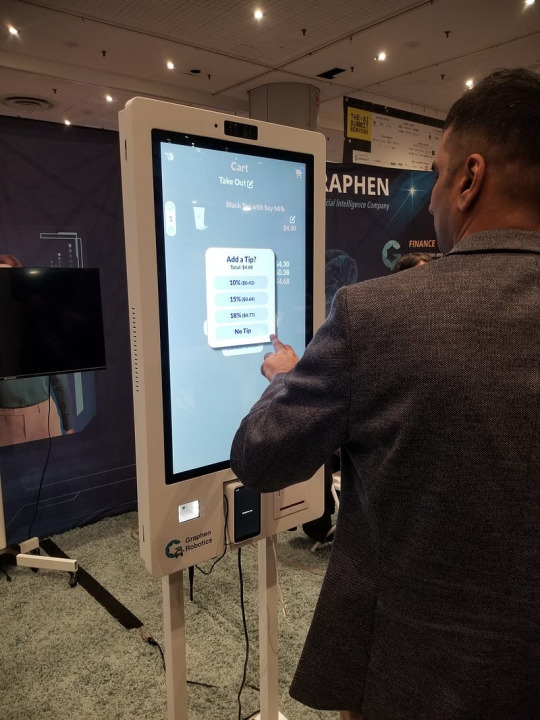
Man orders food AI Kiosk

Man pays for food at AI Kiosk
There were so many great talks and exhibits.
youtube
Additional pictures can be found on Instagram.
I want to thank the AI Summit for having me as their guest. If you want to use AI and Generative to improve business outcomes, sign up for the AI summit in your city.
What do you think is next for AI and Generative AI?
Comment and share below.
Additional pictures can be found on Instagram.
5 notes
·
View notes